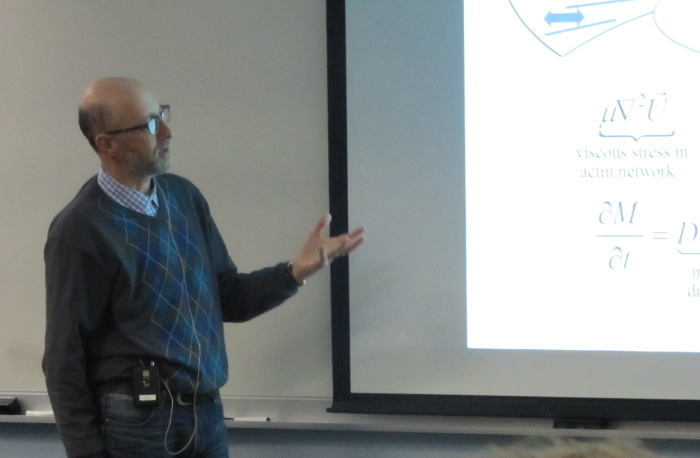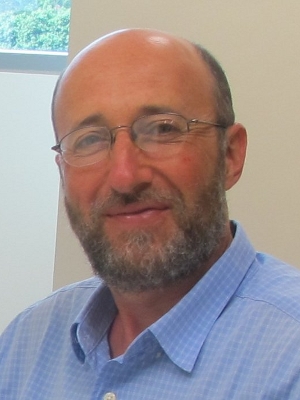NIMBioS Seminar Series
In conjunction with the interdisciplinary activities of the National Institute for Mathematical and Biological Synthesis (NIMBioS), a seminar series on topics in mathematical biology will be hosted at NIMBioS every other Tuesday at 3:30 p.m. (unless otherwise noted) in the Hallam Auditorium, Room 206, Claxton Building, 1122 Volunteer Blvd. Seminar speakers will focus on their research initiatives at the interface of mathematics and many areas of the life sciences. Light refreshments will be served in Room 205 beginning 30 minutes before each talk. Faculty and students from across the UT community are welcome to join us.
Speaker:
Dr. Alex Mogilner, Mathematics and Biology, Courant Institute; Biology, New York Univ.
Time/Date: Tuesday, March 22, 2016, 3:30*
Location:
Room 206, Claxton Building, 1122 Volunteer Blvd.
Topic:
Mechanical pathways of cell polarization and motility initiation
Abstract:
Animal cells move using a polarized dynamic actomyosin network adhering to the surface. While mechanics of motility based on actin protrusion at the front and myosin contraction at the rear are understood fairly well, explanation of spontaneous polarization remains elusive. I will present simulations of a 2D model of a viscous contractile actin-myosin network with a free boundary which, coupled with experimental data, suggests that a positive feedback between myosin aggregation and actin flow and a negative feedback between flow and stick-slip adhesion is the key to understanding self polarization of fish epithelial keratocytes. The model predicts, and experiments confirm, that upregulating myosin accelerates the polarization. On the other hand, epithelial IAR-2 cells self-polarize faster if myosin is inhibited. In that case, combined experiment and theory point out that competition of protruding and contracting actin networks for a common actin pool, coupled with cell movement, is the key to the self-polarization. I will discuss implications of these findings for design principles of cellular self-organization.
Alex Mogilner is a Professor of Mathematics and Biology at the Courant Institute of Mathematical Sciences and a Professor of Biology at New York University. He is on editorial boards of Cell, Journal of Cell Biology, Molecular Biology of the Cell and Bulletin for Mathematical Biology. His theoretical models have investigated the assembly of the mitotic spindle, the behavior of the actin cytoskeleton, and the generation of cell shape and its relationship to cell motility. Some latest projects include modeling of polarization and turning of keratocyte cells, simulating cells as free boundary problem, investigating how cells sense electric field, understanding principles of actin-myosin contraction, elucidating mechanisms of rapid self - assembly and error - correct ion in mitotic spindle, modeling cell crawling in 3D.
Seminar Flyer (pdf)
*Join us for refreshments at 3 p.m.
![]() Live Stream.
Unless otherwise noted, NIMBioS seminars are streamed live.
To view the live stream, visit /videos/livestream.
Join the live chat of the seminar via Twitter (#nimbios), which is displayed to the right of the live stream
We encourage you to post questions/comments and engage in discussion with respect to our Social Media Guidelines.
Live-streamed seminars are archived for later viewing on NIMBioS' YouTube channel.
Live Stream.
Unless otherwise noted, NIMBioS seminars are streamed live.
To view the live stream, visit /videos/livestream.
Join the live chat of the seminar via Twitter (#nimbios), which is displayed to the right of the live stream
We encourage you to post questions/comments and engage in discussion with respect to our Social Media Guidelines.
Live-streamed seminars are archived for later viewing on NIMBioS' YouTube channel.
For more information about this and other NIMBioS Seminars, visit /seminars.

NIMBioS
1122 Volunteer Blvd., Suite 106
University of Tennessee
Knoxville,
TN 37996-3410
PH: (865) 974-9334
FAX: (865) 974-9461
Contact NIMBioS



